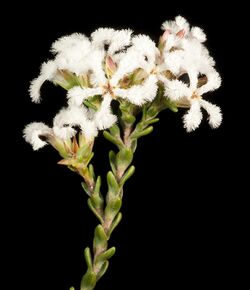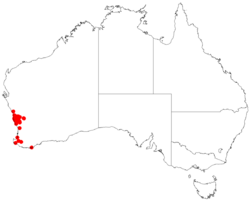Biology:Leucopogon oldfieldii
| Leucopogon oldfieldii | |
|---|---|

| |
| Scientific classification | |
| Kingdom: | Plantae |
| Clade: | Tracheophytes |
| Clade: | Angiosperms |
| Clade: | Eudicots |
| Clade: | Asterids |
| Order: | Ericales |
| Family: | Ericaceae |
| Genus: | Leucopogon |
| Species: | L. oldfieldii
|
| Binomial name | |
| Leucopogon oldfieldii Benth.[1]
| |

| |
| Occurrence data from AVH | |
| Synonyms[1] | |
|
Styphelia oldfieldii (Benth.) F.Muell. | |
Leucopogon oldfieldii is a species of flowering plant in the heath family Ericaceae and is endemic to the south-west of Western Australia. It is an erect or spreading shrub with lance-shaped leaves and dense spikes of white or pink, tube-shaped flowers.
Description
Leucopogon oldfieldii is an erect to spreading shrub that typically grows to a height of 0.4–1 m (1 ft 4 in–3 ft 3 in), its branches and foliage covered with soft hairs. Its leaves are erect, rigid, lance-shaped, 4–8 mm (0.16–0.31 in) long and prominently ribbed. The flowers are arranged in short, dense spikes on the ends of branches or in upper leaf axils, the lower bracts leaf-like and longer than the bracteoles. The bracteoles are tapered and about half as long as the sepals. The sepals are about 3 mm (0.12 in) long, thin and fringed with hairs. The petals are white or pinkish, about 4 mm (0.16 in) long and joined at the base to form a short tube, the lobes 2 or 3 times as long as the petal tube. Flowering occurs from June to September.[2][3]
Taxonomy
Leucopogon oldfieldii was first formally described in 1868 by George Bentham in Flora Australiensis from a specimen collected on the Darling Range by Augustus Frederick Oldfield.[2][4] The specific epithet (oldfieldii) honours the collector of the type specimen.[5]
Distribution and habitat
This leucopogon grows in sand on sandplains in the Avon Wheatbelt, Geraldton Sandplains, Jarrah Forest and Swan Coastal Plain bioregions of south-western Western Australia.[3]
Conservation status
Leucopogon oldfieldii is listed as "not threatened" by the Government of Western Australia Department of Biodiversity, Conservation and Attractions.[3]
References
- ↑ 1.0 1.1 "Leucopogon oldfieldii". https://biodiversity.org.au/nsl/services/apc-format/display/111954. Retrieved 15 March 2023.
- ↑ 2.0 2.1 Bentham, George; von Mueller, Ferdinand (1868). Flora Australiensis. 4. London: Lovell Reeve & Co.. p. 203. https://www.biodiversitylibrary.org/page/11266424#page/212/mode/1up. Retrieved 15 March 2023.
- ↑ 3.0 3.1 3.2 "Leucopogon oldfieldii". FloraBase. Western Australian Government Department of Parks and Wildlife. https://florabase.dpaw.wa.gov.au/browse/profile/6420.
- ↑ "Leucopogon oldfieldii". APNI. https://id.biodiversity.org.au/instance/apni/544753.
- ↑ Sharr, Francis Aubi; George, Alex (2019). Western Australian Plant Names and Their Meanings (3rd ed.). Kardinya, WA: Four Gables Press. p. 265. ISBN 9780958034180.
Wikidata ☰ Q17241705 entry
 |

